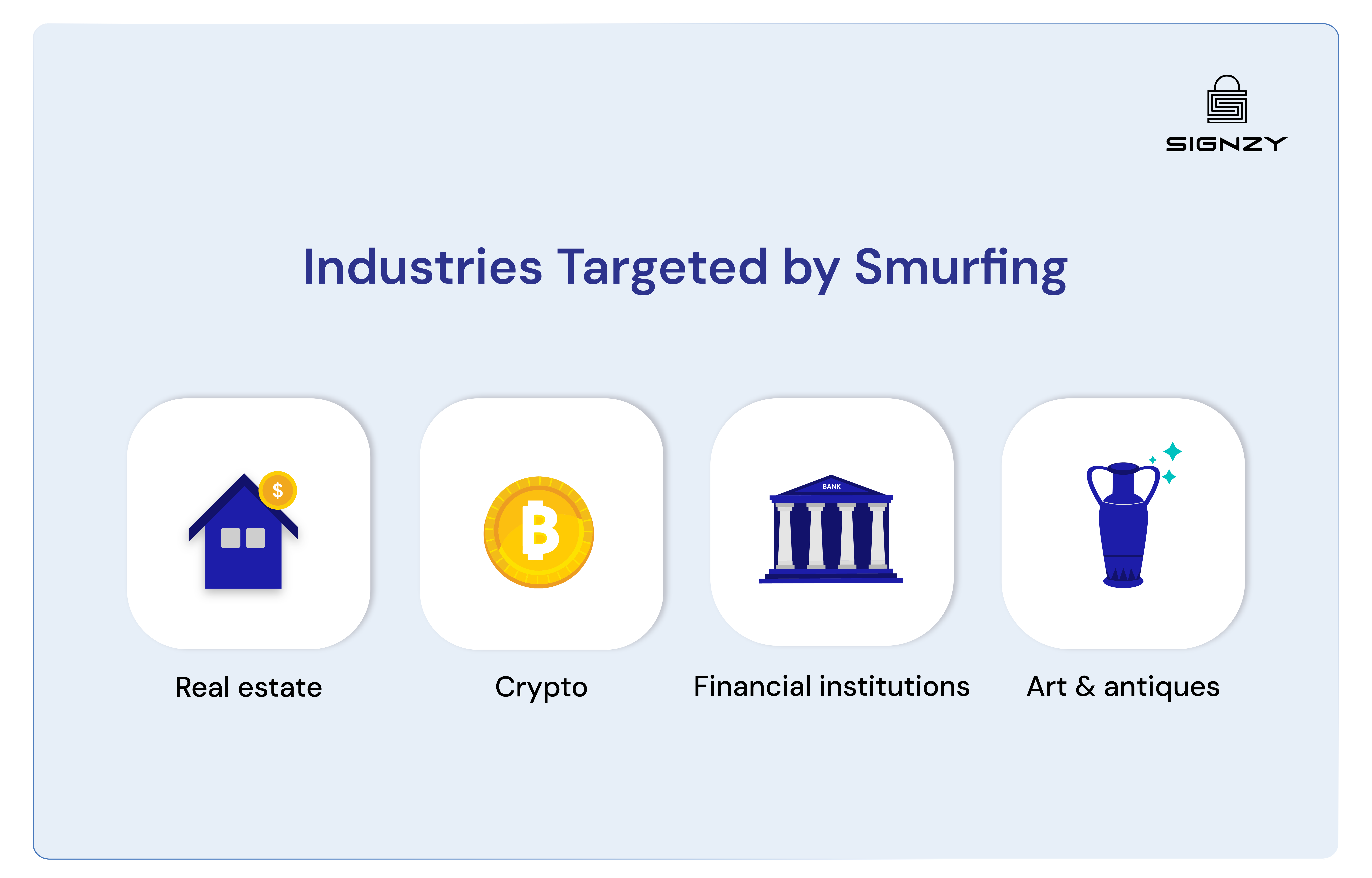What is Smurfing in Money Laundering? Does it affect your business?
- Smurfing is the process of breaking a large amount of money into smaller transactions to avoid detection by banks, financial institutions, and other authorities.
- Although similar, smurfing is not the same as structuring. Smurfing involves the use of multiple accounts to launder illegal money.
- According to an estimate by the United Nations Office on Drugs and Crime (UNODC), every year $800 billion to $2 trillion worth of money is laundered. That’s ~2-5% of the world’s GDP.
We have already discussed money laundering and structuring in detail before. Structuring is a step in the money laundering process where a large amount of money being laundered is broken into smaller transactions to avoid reporting of the illegal funds. However, a term that is often used interchangeably with structuring and is a part of money laundering is “smurfing”. Smurfing is also a method to avoid detection by anti-money laundering authorities, but the two processes differ. Today, we will focus on smurfing, and how it affects your business.
Related Solutions
What is Smurfing?
Smurfing is the process of breaking up a large amount of money into smaller chunks. The point of this fragmentation is to avoid triggering reporting requirements by banks and financial institutions. For example, the Bank Secrecy Act requires banks and financial institutions to record and file reports of any transaction exceeding $10,000.
The process of smurfing involves using multiple accounts associated with different people to move a larger sum of money. These accounts belong to individuals known as “money mules” or “smurfs”. These individuals may be willingly or unwillingly involved in the process. Using these Smurfs or money mules allows the bad actors to distance themselves from the funds while creating an elaborate trail of transactions.
💡 Related Blog:
How does Smurfing Work?
Let us take a look at an example of how exactly smurfing works.
Suppose there is a criminal who wants to transfer $100,000. As we mentioned before, there is a reporting threshold placed by the BSA on banks and financial institutes for transactions exceeding $10,000. So, transferring the entirety of the amount would lead to the bank or financial institution having to record and report said transaction.
This is where the criminal turns to smurfing to avoid this reporting and a connection between them and the illegal funds being established. The criminal could break the $100,000 into 11 transactions worth $9,000 and a $1,000 transaction.
Now, breaking up these funds removes the risk of the criminal getting reported due to the transaction volume. However, 12 transactions from a single account would put the bad actor under suspicion again due to the high volume of transactions.
To avoid this detection, the bad actor will choose more than one bank account to complete this transaction. These accounts can either belong to the bad actor themself, created using fake identities, or other people. This usage of multiple accounts and individuals is one of the factors that separates smurfing from structuring.
The individuals other than the bad actors who get involved in the process are called “smurfs” or “money mules”. They may get wrapped up in the whole affair knowingly or unknowingly. The unknowing smurfs may be the bad actors’ vendors or other recipients, who are just used as layers of transactions in the money laundering process.
What is the Difference between Smurfing and Structuring?
As we mentioned before, smurfing and structuring are closely related to the money laundering process. So much so, that these terms are often used interchangeably. However, these two processes are inherently different, let us understand the differences between these two terms.
The biggest difference is the number of accounts or individuals involved in the process. As we’ve discussed before, structuring involves breaking up a large sum into smaller transactions to avoid triggering a bank or financial institution’s reporting requirements, just like smurfing. However, structuring takes place through a singular account or multiple accounts belonging to the same person. Smurfing involves the use of smurfs or money mules, who help the bad actor avoid suspicion by reducing the number of transactions by the same account or individual.
Apart from this major difference, here are a few other differences between structuring and smurfing:
| Structuring | Smurfing | |
|---|---|---|
| Illegal | Yes | Yes |
| Concealed Source of Funds (SoF) | Not always | Yes |
| Illegally obtained funds | Not always | Yes |
| Geographical movement of funds | Not always | Yes |
| Physical movement of cash (placement) | Not always | Yes |
Industries Targeted by Smurfing

Certain industries are at a higher risk of being targeted by individuals or organizations trying to launder money through smurfing. The businesses in these industries need to take extra measures to ensure proper reporting of activities that might raise suspicion of smurfing or similar illicit activities. Let us take a look at these industries:
- Real estate: Bad actors use real estate to make multiple transactions in the form of EMIs directed toward buying properties.
- Crypto: Repeated investments and sales of cryptocurrencies allow people with illegal funds to cycle them into the economy.
- Financial institutions: These include banks and money service businesses. This sector is at the greatest risk of being exposed to smurfing as bad actors move their funds through banks, FIs, money service businesses, and more to inject illicit funds back into the economy.
- Art and antiques: Similar to cryptocurrencies, individuals trying to smurf money make frequent purchases of art and antique items.
Since these industries are at a higher risk of being exposed to money laundering, they need to take stronger AML measures to avoid legal liabilities and maintain a safe environment for their customers. The best way to go about this is to employ professional help, like Signzy.
AML solutions with Signzy
Money laundering as a problem has ballooned severely over the last few years. The United Nations Office on Drugs and Crime (UNODC) estimates that the amount of money laundered every year globally is around $800 billion to $2 trillion. That’s ~2-5% of the world’s GDP.
With the AML/CFT rules, your businesses are responsible for taking a risk-first approach in countering money laundering and terror financing. Failing to meet the compliance requirements can lead to your business facing legal and financial problems. Signzy’s bank account verification API can help your business validate the bank account details of its customers in a fast and seamless fashion. Adding other identity verification methods like Signzy’s DL Verification API, SSN Verification API and other identity verification methods from our API marketplace can help your business build a robust KYC environment. Book a demo with us to find out how Signzy can partner with you.
Conclusion
Structuring and smurfing are only some of the problems that businesses face today. While the measures mentioned above can help your business curb the problem presently, vigilance is necessary to keep your business’s security measures up to date. A secure operating environment does not just help your business avoid legal problems but also helps build better customer relationships by ensuring that their association with you is safe.
FAQ
What is smurfing in money laundering?
What is the difference between smurfing and structuring?
Are smurfing and structuring illegal?

Tanya Narayan
Tanya is a Product Marketing Manager at Signzy and a GrowthX Fellow, with a strong focus on SaaS and fintech. She specializes in go-to-market strategy, customer research, and positioning to help teams bring products to market effectively. She has also cleared the Company Secretary foundation level, reflecting her grounding in corporate and compliance fundamentals.


